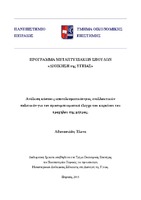Ανάλυση κόστους-αποτελεσματικότητας εναλλακτικών πολιτικών για τον προσυμπτωματικό έλεγχο του καρκίνου του τραχήλου της μήτρας
Cost-effectiveness analysis on alternative triage policies for cervical cancer screening

View/
Subject
Ιατρική περίθαλψη, Κόστος τηςAbstract
Cost-effectiveness analysis (CEA) is technique that compares relative costs and outcomes (effects) of alternative health interventions used for the same health outcome. Using this tool facilitates the comparison of different health technologies, when outcomes are measured with the same unit (life-months, life years) and costs are calculated in the same monetary unit. The incremental cost effectiveness ratio (ICER) is defined by the difference in cost between two possible interventions, divided by the difference in their effect. It represents the average incremental cost associated with 1 additional unit of the measure of effect. ICER focuses on interventions that are more expensive and more effective. If a willingness-to-pay value is established, for the outcome of interest, it is possible to adopt this value as a threshold. If ICER is above this threshold it will be considered too expensive and thus should not be funded, whereas if the ICER lies below the threshold the intervention can be judged cost-effective. Additionally, different health interventions can be ranked and thus decision makers are able to proceed efficient policy making.
Precancerous lesions can be detected years before cancer occurrence, giving the possibility of effective prevention. Organised screening is based on cytological examination of cervical smears with test Papanicolaou. Nowadays, molecular testing for HPV is used as ancillary tests in screening. Pilot studies can be implemented as quality control indicators of screening programs in order to assess molecular testing in terms of cost-effectiveness.
Economic models have been widely constructed in order to assess different tests for HPV detection. The present study aims to assess decision support system based on advanced clinical theranostics protocols for the cost-effective, personalized management of HPV related diseases. In order to develop the proposed system a combinatorial approach of high throughput technologies will be used; a) Molecular biology techniques: DNA micro-arrays, mRNA detection, multiparameteric Flow Cytometry (FC), Cytomics and Methylomics, and b) Bioinformatics, Computational Modelling and Artificial Intelligence methods. Cumulative risk scenarios that are
expected to be produced as outputs of the proposed system will be accessed and further processed with financial feasibility methods.
In order to make the analysis costs included the costs of each test (implied by unit cost of each participating laboratory) and the transportation cost calculated for each woman through a probabilistic allocation. Positive predictive value (PPV) and Youden’s Index were calculated for all tests (including the proposed system –CDSS) in order to measure effectiveness.
Results: CDSS is associated with increased effectiveness and elevated costs, implying that a broad implementation of the system in general population is discouraged. On the other hand, it could be clinically justified in certain sub-groups with significant social interest (high risk women, populations with limited access to health services etc).


